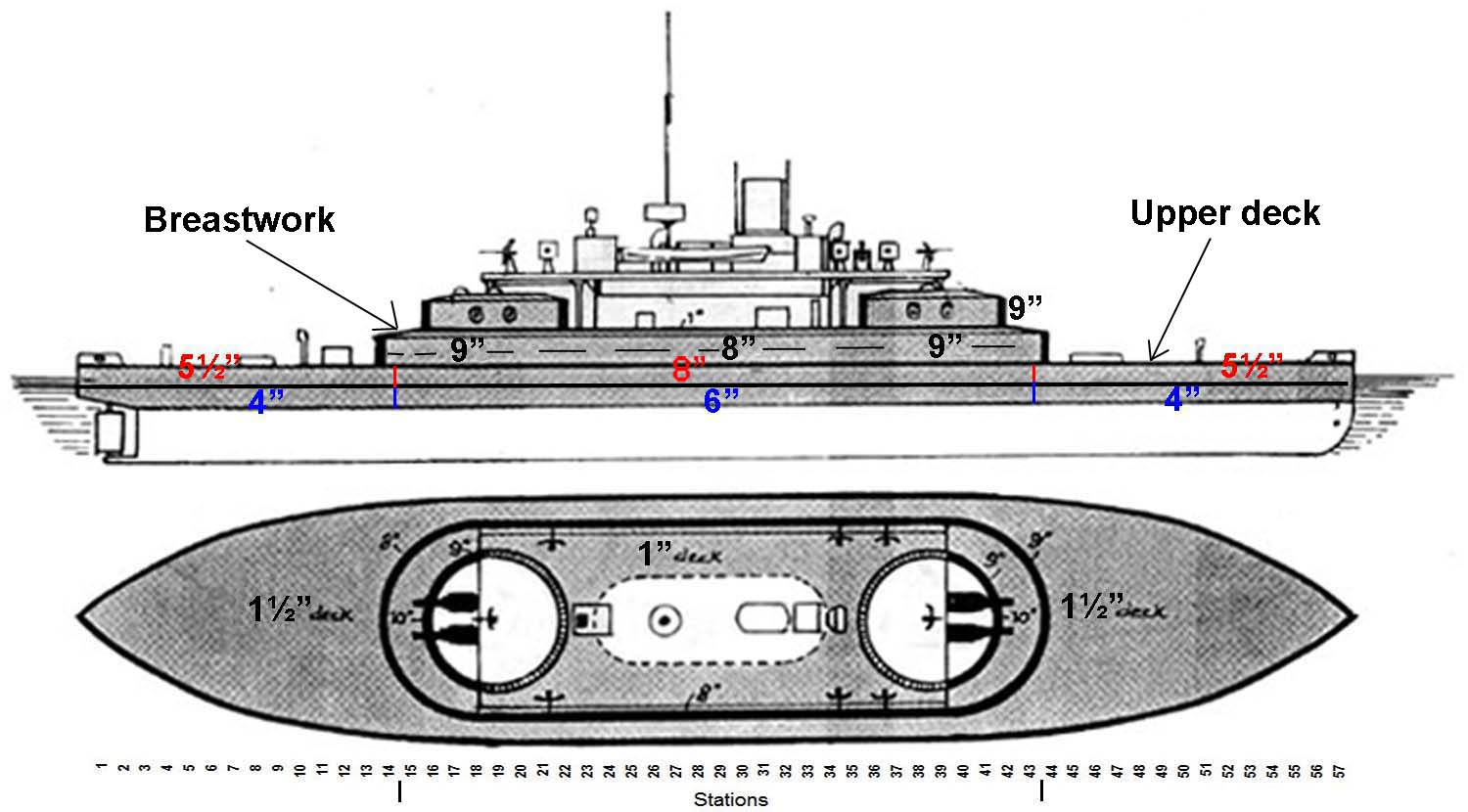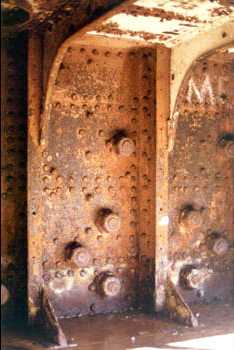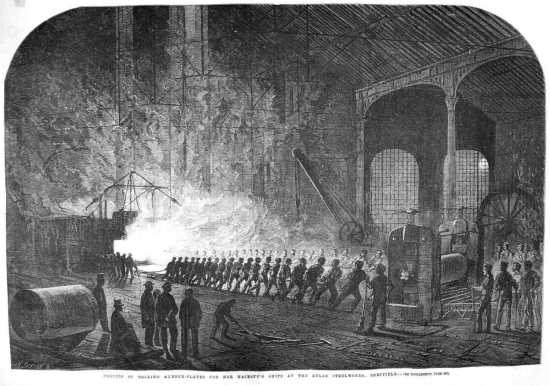
Note: The Main Armour Belt's two strakes are shown, with thickness in red (top strake) & blue (bottom strake). As both of the breastwork deck strakes are the same thickness, they are shown as a dashed line.
Click image to enlarge.
Selected armour plates, intended for ships under construction, were tested by being fired at. If the tests were satisfactory, the entire cost of the plates tested was borne by the Government, if unsatisfactory, by the contractors. Fortunately for us, many of the armour plate tests were published in the newspapers of the day. Researching turned up three armour plate tests for Cerberus and one for her sister ship, Magdala. Fortunately for the manufacturer, all four plates passed the tests of being hit from a distance of about ten metres, by nine, twelve or eighteen 68 pound and 7 inch shot.
| Ship | Date | Position on Ship | Manufacturer | Thickness | Length | Width | Weight |
|---|---|---|---|---|---|---|---|
| Cerberus 12 | Feb. 1868 | ? | Cammell & Co. Cyclops Steel & Iron Works | 8 inches | 14 feet | 3 ft 9 in | 7.52 tonnes |
| Cerberus 4 | March 1868 | Main Belt | Cammell & Co. Cyclops Steel & Iron Works | 8 inches | 12 feet | 3 ft 6 in | 6.02 tonnes |
| Cerberus 10 | Aug. 1868 | Turret | Cammell & Co. Cyclops Steel & Iron Works | 9 inches | 14 feet | 3 ft 6 in | 7.9 tonnes |
| Magdala 8 | Dec. 1869 | Breastwork | Sir John Brown & Co. Atlas Works | 9 inches | 12 ft 5 in | 3 ft 3 in | 6.5 tonnes |
Two strakes of 3 feet 6 inches in height. The top strake is 8 inches thick below the breastwork tapering fore and aft to 5½ inches. The lower strake is 6 inches thick below the breastwork tapering fore and aft to 4 inches.
"The upper Strake on the Ship's side is to be 8 inches and the lower Strake 6 inches thick. The Plates are to be worked their full thickness from Station 15 to Station 43, before and abaft which stations the Plates are gradually to taper in thickness,
the upper Strake is to taper from 8 inches to 5½ inches at the extremities, and to [backed with 11 inches of teak, tapering with armour]
the lower Strake from 6 inches to 4 inches. The Plates forming the tapered portions of the Armour are not to taper individually but each Plate is to be of the same thickness throughout, that thickness being the mean thickness of the Plate supposing it were to taper; these Plates will have to be let into the Backing in Steps."1 [backed with 10 inches of teak, tapering with armour]
"This armour is in two strakes, the upper one being 8 inches thick, and the lower one six inches, both tapering towards the extremities of the vessel. The armour and backing are worked upon a recessed armour-shelf, so as to make the line of the side a continuous curve as in broadside vessels, and contrary to the practice adopted in the American monitors and the Glatton."3
"The upper 3 ft. 6 ins. is plated with armour 8 in. thick, and the 3 ft. 6 in. below with armour 6 in. thick, tapering 5 in. and 4 in. towards the fore and aft parts."6
"Her freeboard is 3 feet, the side being covered with armour from stem to stern, and to about 4 feet below the waterline. This armour is in two strakes, the upper one being 8 inches and the lower one 6 inches thick, each tapering towards the extremities of the vessel to 5½ inches and 4 inches respectively. The teak backing is worked horizontally between two outside stringers, and the whole secured to two thicknesses of ⅜ in. plating.
Her frames are 3ft. apart, excepting in the double bottom, which extends from the armour shelf on one side of the armour shelf on the other through the whole length of the midship body, where the frames are 4ft. apart.
The keel is composed of two flat plates, strengthened by a continuous vertical keelson. There are also four longitudinal frames, composed of steel plates, running fore and aft the vessel on each side of the keel, the upper longitudinal forming the shell or recess for armour. The remainder of the hull is built of iron."7
8 inch Armour Plate Trials"Trials of armour plates, of Sheffield manufacture, took place last week on board the Thunderer. Those under trial were selected by the Admiralty inspector, Mr. J. Luke, from a number of rolling mills of Messrs. Charles Cammell and Co., Cyclops Steel and Iron Works, and comprised an 8-inch plate, for the colonial turret ship Cerberus, building at the Palmer Shipbuilding Company's Works at Jarrow-on Tyne....... |
|
"The Ironmonger" (England) reprints recently an extract from its issue of 1868, as follows:— An Armour Plate Test"The first selected test armour plate for the turreted ironclad Cerberus, building for the Colony of Victoria under the superintendence of the Admiralty at Jarrow, was passed through its trial on Wednesday at Portsmouth most successfully. Eighteen test shots in all were fired at it in two clusters, nine shots being planted in one cluster, with edges of indents overlapping at each end. The plate, manufactured by Messrs. Charles Cammell and Co., proved of very superior quality in metal and in manufacture." |
Two strakes of 3 feet 3 inches in height. Both strakes are 8 inches thick at the centre of sides of the breastwork and 9 inches thick below the turrets.
"The Armour on the Breastwork is to be 8 inches thick in the midship portion, and 9 inches thick in wake of the Turrets, as shown on the Plan of Upper Deck."1
"It stands upon the midship part of the upper deck, and is 112 feet long, 34 feet wide, and 6 feet deep, having circular ends, which are protected by 9 inch armor in the wake of the turrets. Elsewhere 8 inch armor is placed on the sides of the breastwork; the frames are 3 feet apart, and well secured to the upper deck beams." 7
The following details of Magdala (sister ship of Cerberus) HMS Cyclops (based on Cerberus) indicate that the breastwork armour consisted of two strakes measuring 3 ft. 3 in. with both strakes being 8 inches thick at the sides of the breastwork and 9 inches thick at the ends.
9 inch Armour Plate Trials"On Tuesday, an armour-plate, weighing 128 cwt., and measuring 12 ft. 5 in. in length by 3 ft. 3 in. in breadth, and 9 in. thickness, selected by Mr. Luke, the Admiralty surveyor, from a quantity manufactured by Sir John Brown and Co., Atlas Works, Sheffield, for her Majesty's ship Magdala, was tested at Portsmouth, under the supervision of Captain Boys, her Majesty's ship Excellent, inaugurating the new system of testing plates, by Admiralty order, which brings the 7-inch rifled gun with the Palliser ogival-headed projectile into use against the plate as well as the 68-pounder smooth-bore with its spherical shot." |
"To be 8 inches and 9 inches thick, as shown upon the Plans, worked and secured as may be directed; and to be subject to all the Conditions before described under the heading of Armour Plating."1
"its sides are protected with 9 inch armour and its ends with 8 inch."3
"The surfaces of the Upper Deck outside the Breastwork is to be covered with two thicknesses ¾ inch Plating"1
"The surface of the Deck over Breastwork is to be covered wrth two thicknesses of ½ inch Plating"....."⅜ inch Plating within the Breastwork"1
"The surface of the Flying Deck is to be plated with ⅜ inch plating wherever directed."1
"To be 10 inches thick on the front, and 9 inches on the back as shown upon the Plan of Turret, the Plates to be worked horizontally and fastened with Iron Bolts 3½" diameter having conical heads."1 [The ten inch armour is only immediately around the gun ports with the rest of the turret having nine inch armour. Observation indicates that there are two strakes of armour]
A test carried out on one of the 9 inch Cerberus turret plates on the 25th of August 1868, indicates that it was 14 feet by 3 feet 6 inches and made by Messrs. Cammell and Co.10
"the turrets are plated for 23 feet of their depth with 10-inch armour plating, supported by 10-inch wood backing, and lined with 2⅝ plate lining, and further supported by a 10-inch angular-iron frame."11
[This indicates that the 10 inch armour plates straddling the gunports had a total length of 23 feet. The other 59 feet of the turret's circumference consisted of 9 inch armour.]
9 inch Armour Plate Trials"One of the nine-inch armour plates, manufactured by Messrs. Cammell and Co., of Sheffield, for the turret of the Cerberus, was tried on board the target ship, Thunderer, in Porchester lake, yesterday morning. The size of the plate was about 3 feet 6 inches by 14 feet, and twelve 68-pounder shots were fired, being concentrated on about one-third of the space. The result of the test was considered highly satisfactory." |


1 Armour dimensions are from Specification for a twin Screw Iron Armour-clad Turret Ship of 2107 Tons, With Monitor Deck and Raised Breastwork, for Melbourne. reprinted from The Three Headed Dog courtesy of Bob Nicholls.
2 Calculated using the density of wrought iron of 7,750 kg/m3
3 Glasgow Herald, 11 December 1868
4 Practical Mechanic's Journal, 1 April 1868.
5 The Argus, 21 April 1868
6 The Argus, 10 March 1871
7 The Sydney Empire, 2 May 1868. from The Engineer, 7 February 1868
8 Sheffield Independent, 18 December 1869
9 The Star, 22 July 1871
10 London Standard, 26 August 1868
11 The Inquirer & Commercial News (Perth, WA), 22 March 1871
12 Sheffield Daily Teleghraph, 7 February 1868